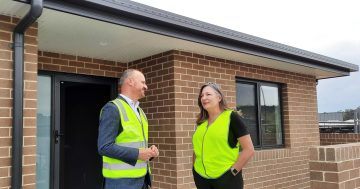
Canberra needs more housing choices, architects say. Photo: Michelle Kroll.
Canberra architects are calling for the roles and authority of the Design Review Panel and the ACT Government Architect to be beefed up to improve planning and development outcomes in the Territory.
In its submission to the planning system review, the ACT Chapter of the Australian Institute of Architects wants both offices to be better resourced and the Chief Planner to be compelled to consider the Panel’s advice on all projects it examines.
The Institute says that for the government to achieve its good design objectives in the new Planning Bill, the Panel and the Government Architect must have the funding and support staff from the Planning Authority to do their jobs.
“Funding and resourcing must be increased to align with the expectations of the new system and the current economic context to reduce risk and deliver on good quality outcomes,” the Institute says.
“The Design Review Panel should be comprised of qualified and respected design professionals and should be refreshed at regular intervals to enable both consistency and a diversity of perspectives.”
The Institute says the ACT should come into line with other jurisdictions and recognise that qualified design and engineering professionals are required to ensure the quality of significant projects.
It adds that the Chief Planner should be able to override the advice of entities and approve developments based on what the Panel says if they believe there will be a better quality outcome.
Instead of the Minister setting the good design principles for the Panel to follow, the Institute says the principles should be defined in the legislation so all parties are on an even playing field.
The Institute also calls for a number of changes to streamline the system, enable the transition to a compact city and support climate resilience.
It calls for a “maximum building plot ratio and maximum envelope” to be included in the Bill to enable flexibility and innovation in good design approaches, including the number of floors allowable.
A “maximum hardstand plot ratio” should also be included to minimise adverse heat island effects by reducing excessive hardstand, turning circle, driveway and car parking requirements.
The Institute believes a “green plot ratio” encompassing tree canopy and other green infrastructure would be more successful at encouraging good design, innovation and maintaining biodiversity than the current system of protecting individual trees.
The Institute says all new developments in the ACT should consider their carbon footprint and contribution to reducing the heat island effect.
It also wants the term “economic development” to be replaced with “sustainable development” to avoid unintended consequences.
But approvals for multi-dwelling urban infill developments should be simplified, especially in older areas with large blocks, where the proposal is designed as a cohesive single residential form such as a duplex, manor house, and multigenerational residential complex.
“The new planning system must incorporate streamlined approval pathways for urban infill to provide modest, sustainable and affordable housing to deliver on compact city goals that are equitable across our community,” the Institute says.
“There needs to be a move away from the current system of excessive, extended approval processes that can result in neighbourhood friction to a better planning system that delivers affordable, social, equitable and sustainable outcomes.”
The Institute says proponents need more certainty and approvals should occur within reasonable timeframes or be deemed approved or proponents compensated.
“It is the responsibility of the government to ensure that the Territory Planning Authority and referral agencies such as ACT Heritage and TCCS [Transport Canberra and City Services] have the number of staff with the necessary qualifications required to meet its statutory obligations,” it says.
ACT Chapter President Jane Cassidy noted the review was a once-in-a-generation opportunity to create a better planning system for Canberrans that could promote greater housing choice, affordability, and design innovation while tackling the challenges of climate change.
“Canberra is a fast-growing city and we need an integrated planning system that puts people first through a strong focus on great design,” Ms Cassidy said
“We’re also calling on the Government to integrate its planning reforms with other ACT Government policies such as the ACT Government Infrastructure Plan to ensure critical net-zero carbon 2030 and 2050 goals are met.”





















